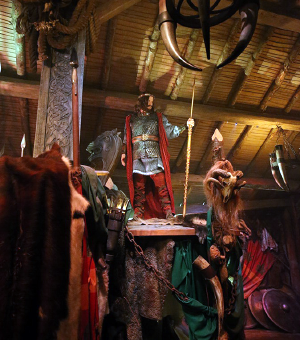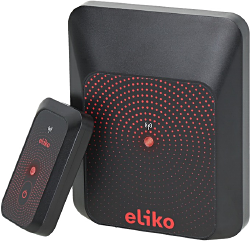Original blog post: https://www.qorvo.com/design-hub/blog/lights-camera-action-uwb-is-the-star-supporter-in-le-premier-royaume
With all the potential use cases for ultra-wideband (UWB) technology, it’s not surprising that it’s often found in the most unexpected places. Case-in-point: the Puy du Fou theme park in France. A recent article in blooloop outlines how UWB rescued its show “Le Premier Royaume” (“The First Kingdom”), a multi-sensory walkthrough experience set in fifth-century France, in which guests journey through the history and legend of the Frankish King Clovis.
According to the article, “During the experience, five hundred theater goers move through the sets, as eight actors execute perfectly timed entrances and exits. This is supported by lights, sound, and special effects.” The show cycles for seven hours a day, using 14 different sets throughout roughly 24,000 square feet on two levels. The challenge for the show producers was to keep pace with the visitors moving through the spaces and timing the activation of the show’s effects.
That’s where UWB came in. Puy du Fou turned to Eliko’s UWB RTLS system, which integrates Qorvo’s UWB devices and can track hundreds of objects in real-time.
Here we explore why UWB technology is conducive for precision-dependent use cases.
Eliko’s UWB RTLS system integrates Qorvo’s UWB devices and can track hundreds of objects in real-time.
UWB: Solving the ‘Where’
In show business, timing is everything. Especially for the Le Premier Royaume performance. What’s also critical for the show’s success is the ‘where.’ The timing of the lighting, special effects, actors are all based on where the audience is located in relation to its location within the theater. We have many technologies—BLE, Wi-Fi, RFID, etc.—and apps built into so many of our devices that accurately track the ‘when’ and inform us of ‘what.’ But they’re not designed to track the ‘where,’ the precise location in real-time—second by second. However, this is exactly what ultra-wideband does.
With UWB, the show’s production could synch all the devices so the apps always know precisely where things are—down to the centimeter and the second. Being a low-power, ultra-wide bandwidth radio technology, UWB offers characteristics that make it ideal for use cases such as Puy du Fou’s—the most important in this case are precision ranging, precise location, and fast data communication.
Why UWB?
To better understand why UWB, in particular, is the most conducive for applications like Puy du Fou’s – a challenging environment for RF technologies – let’s take a look at how it compares to other technologies like BLE and Wi-Fi. This table shows that UWB has all the ingredients to overcome the show’s challenges.

A scene from “Le Premier Royaume” (“The First Kingdom”), a multi-sensory walkthrough experience set in fifth-century France.
| UWB | Bluetooth® Low Energy | Wi-Fi | |
| Accuracy | Centimeter | 1-5 meters | 5-15 meters |
| Reliability | Strong immunity to multi-path and interference | Very sensitive to multi-path, obstruction and interference | Very sensitive to multi-path, obstruction and interference |
| Range/coverage | Typ. 70m Max 250m |
Typ. 15m Max 100m |
Typ. 50m Max 150m |
| Data Communications | Up to 27 Mbps | Up to 2 Mbps | Up to 1 Gbps |
What sets UWB apart the most from the other technologies is its accuracy. Like other location technologies, UWB doesn’t rely on satellites for communication. Instead, devices containing UWB technology (like antennas on the show’s actors, lighting, cameras, etc.) communicate directly with each other to determine location and distance. What’s different about UWB from the others is this accuracy is achieved by measuring the time that it takes signal pulses to travel between devices, which can be calculated based on the time-of-flight of each transmitted pulse.
The accuracy of this method depends on the signal’s bandwidth; very wide signals are needed to achieve high accuracy. UWB signals use roughly 500 MHz of bandwidth—many times wider than other technologies sometimes used for location sensing. That enables UWB to achieve centimeter precision, which is critical for many applications.
UWB technology also works in non-line-of-sight conditions where the use of cameras to track location is not possible. This means that the signal is capable of going through obstructions like the sets while maintaining a very high location accuracy. In addition, as it operates at frequencies between 6 and 8GHz, it has no interference issues with other radio waves.
For more in-depth information about how UWB technology works, read the whitepaper, Getting Back to Basics with Ultra-Wideband (UWB).
Check Out Other UWB Use Cases
UWB is an old radio technology enabling new opportunities for rich real-time applications. Companies and application developers are already enabling new UWB-based services that benefit both businesses and individuals. But they are only scratching the surface. There are many use cases where UWB can create an experience and enrich our personal lives. For more ideas on use cases, watch this video. You can also read about how UWB is used at the Museum of the Bible to enhance the visitor experience, as well as how Volkswagen is optimizing its production by integrating UWB into its operations.
The Bluetooth® word mark and logos are registered trademarks owned by Bluetooth SIG, Inc. and any use of such marks by Qorvo US, Inc. is under license. Other trademarks and trade names are those of their respective owners.

